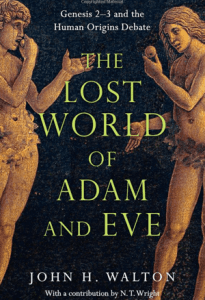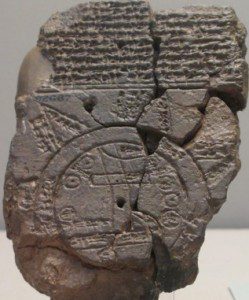 The next two propositions in John Walton’s new book The Lost World of Adam and Eve focus on the use of the word ˀādām in Genesis 1-5 and on the purpose of the creation accounts found in Genesis 1 and Genesis 2. In this post we will consider both of these propositions.
The next two propositions in John Walton’s new book The Lost World of Adam and Eve focus on the use of the word ˀādām in Genesis 1-5 and on the purpose of the creation accounts found in Genesis 1 and Genesis 2. In this post we will consider both of these propositions.
Once upon a time there was a man named Human. The first thing to note is that the word ˀādām is a Hebrew word meaning human. It is used in a variety of ways in Genesis 1-5. It is used as the term for human referring to human beings as a species, it is used to refer to the male of the species, and it is used to refer to a particular male individual functioning as a name. However, Walton also points out that ˀādām is a Hebrew word and Hebrew as a language did not exist until “somewhere in the middle of the second millenium B.C.” that is, after the Patriarchs.
If these are not historical names, then they must be assigned names, intended by the Hebrew-speaking users to convey a particular meaning. Such a deduction leads us to the second observation. In English, if we read that someone’s name is “Human” and his partner’s name is “Life,” we quickly develop an impression of what is being communicated (as, for example, in Pilgrim’s Progress, where characters are names Christian, Faithful, and Hopeful). These characters, by virtue of their assigned names, are larger than the historical characters to whom they refer. They represent something beyond themselves. Consequently, we can see from the start that interpretation may not be straightforward. More is going on than giving some biographical information about two people in history. (p. 58-59)
This is a case where transliteration into English may obscure the meaning of the text. Walton suggests that the only places where the word should be transliterated as a name are in the genealogies of Genesis 5:1-5. Genesis 4:1 and 25 are anomalous. But in Genesis 1-3 the word is generic referring to mankind or is referring to “an individual serving as a human representative.”
Such representation could be either as an archetype (all are embodied in the one and counted as having participated in the acts of that one) or as a federal representative (in which one is serving as an elect delegate on behalf of the rest). In either case the representational role is more important than the individual. Only in cases where the word is indefinite and by context being used as a substitute for a personal name would the significance be tied to the individual as an individual, historical person. (p. 61)
The story of the man named Human and the woman named Life is about more than two people with given names Adam and Eve. Walton considers Human and his wife, Adam and Eve, to have been genuine historical characters. This will come up later in his book. However, the purpose of the text is bigger than relating the history of these two individuals. Consideration of the structure of Genesis 2 helps to make this clearer.
 Genesis 2 is not an expanded account of Day Six. Many people have noticed and commented on apparent inconsistencies between the creation accounts of Genesis 1 and Genesis 2. Some try hard to homogenize the accounts restoring the expected internal consistency. Others simple accept them as competing accounts that cannot be reconciled – that is, they are inherently contradictory. Walton suggests a third possibility.
Genesis 2 is not an expanded account of Day Six. Many people have noticed and commented on apparent inconsistencies between the creation accounts of Genesis 1 and Genesis 2. Some try hard to homogenize the accounts restoring the expected internal consistency. Others simple accept them as competing accounts that cannot be reconciled – that is, they are inherently contradictory. Walton suggests a third possibility.
The accounts are not internally consistent if Genesis 2 is reporting on the same event as Genesis 1. In Genesis 1 the earth brings forth plants on Day Three and humans are created after the animals on Day Six. In Genesis 2 the man is formed from dust before plants grow and before the animals are formed. These difficulties can be smoothed in translation, but this doesn’t seem to be quite the right approach. Walton also points out that it strains credulity that the man named all the livestock, the birds in the sky, and all the wild animals in one 24 hour day.
Dismissing the problems as “errors” in the text has problems of its own. It seems unlikely that the authors/editors of the text simply pasted two accounts together for no important reason. The text is constructed as it is to convey meaning.
Walton suggests that Genesis 2 is a sequel to Genesis 1. He supports this hypothesis using the literary structure of Genesis. Genesis 2:4 introduces the second account with a literary formula “this is the account of” (tōlĕdōt) found 11 times in Genesis. In all of the other cases this formula is followed by a narrative of a genealogy or by the actions of a person’s son’s. Thus, it is possible, even likely, that the introduction “This is the account of the heavens and the earth when they were created, when the Lord God made the earth and the heavens” in Genesis 2:4 is followed by the events that occurred after the creation of the earth and the heavens rather than a recapitulation of the creation story.
As a sequel, Human and his wife in Genesis 2 may or may not have been among the humans referred to in Genesis 1:26-28. The text does not demand that they be the first couple, among the first humans, or the only people living at the time. Moving forward to Genesis 4, this removes the conundrum of Cain. There was a community from whom he found a wife, of whom he was afraid, and with whom he built a city. The text of Genesis does not appear to assume that Human and his wife Life were the only humans alive and raising a family. This wasn’t a problem to the original editors/authors.
What about the plants? Walton notes that Genesis 2:5-6 focuses on cultivated plants rather than general vegetation. It is common in ancient Near Eastern literature to find descriptions of an inchoate (just begun and so not fully formed or developed) world. Either humans or gods are required to produce order in the world. Walton gives a number of examples and then sums up:
For our purposes, we should note that the kind of description found in Genesis 2:5-6 is of the same sort that is common in cosmological texts of the ancient world when a terrestrial pre-ordering condition is being described. Genesis is featuring the same sorts of discussions known in that world, though it often has a different perspective on them. (p. 68)
Two conclusions about the purpose of Genesis 2. These considerations lead to two important conclusions concerning the purpose and meaning of the story related in Genesis 2. This is not about the creation of the world, it is about humans in God’s sacred space. According to Walton: (p. 69)
- Genesis 2 explains how humans function in sacred space and on its behalf (in contrast to Genesis 1, which addressed how sacred space functioned for humanity).
- Genesis 2 locates the center of sacred space (the garden) in contrast to Genesis 1, which only indicated that the cosmos was set up to be sacred space.
So what? Whether one considers Adam and Eve as historical characters and views Genesis 2 as a type of historical sequel to Genesis 1 (as Walton does), or views Genesis 1-3 as of a more general literary character, there are a couple of important insights that come from this discussion. First, Human and his wife Life represent more than simple two unique individuals. Second, there is no reason to think that two contradictory accounts were simply pasted together to start the Bible. Nor is there any reason to dismiss the accounts as ancient cosmology and “science” with a modicum of a message. There is a reason that the authors/editors brought these accounts together to convey a message.
Walton’s discussion of the purpose of the “names” and the point of Genesis 2 as humans functioning in God’s sacred space makes sense of the text in a far more powerful ways that both wooden literalism and scholarly dismissal entirely overlook. This is a meaning on which we should focus.
What do Human and his wife Life signify in Genesis 2?
Does the transliteration into names without English meaning confuse meaning?
Is it reasonable to think of Genesis 2 as a sequel to Genesis 1?
If you wish to contact me, you may do so at rjs4mail[at]att.net.
If interested you can subscribe to a full text feed of my posts at Musings on Science and Theology.















